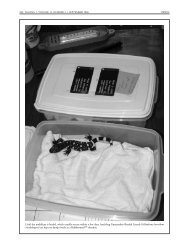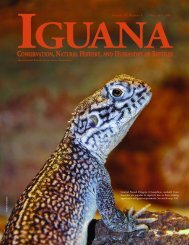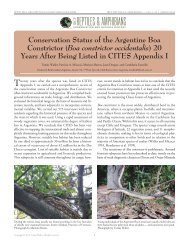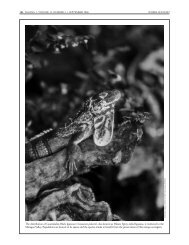Spiny-tailed Iguanas (Ctenosaura similis) in Venezuela
Spiny-tailed Iguanas (Ctenosaura similis) in Venezuela
Spiny-tailed Iguanas (Ctenosaura similis) in Venezuela
Create successful ePaper yourself
Turn your PDF publications into a flip-book with our unique Google optimized e-Paper software.
PETER J. MUELLEMAN<br />
AMPHIBIANS AND REPTILES OF DOMINICA<br />
Dom<strong>in</strong>ican Republic, southern Florida, and Costa Rica. These<br />
moderately sized anoles (male SVL to 77 mm, female SVL to<br />
73 mm) typically exploit edge habitats <strong>in</strong> heavily disturbed areas<br />
along roadsides and <strong>in</strong> open fields and woodlands from sea level<br />
to elevations of ~980 m on the Puerto Rico Bank. Females and<br />
juveniles often forage on the ground. Lizards usually are light to<br />
dark brown and even greenish gray, often chang<strong>in</strong>g color<br />
depend<strong>in</strong>g on mood. Pattern elements <strong>in</strong>clude small dark spots,<br />
saddle-shaped mark<strong>in</strong>gs, or dist<strong>in</strong>ct cross-bands. A light longitud<strong>in</strong>al<br />
middorsal stripe bordered by narrow dark l<strong>in</strong>es is common<br />
<strong>in</strong> females but can be found on some, especially smaller<br />
males. Although primarily diurnal, they are known to extend<br />
activity to after dark, exploit<strong>in</strong>g <strong>in</strong>sects attracted to artificial<br />
lights. These sit-and-wait foragers eat ma<strong>in</strong>ly small arthropods,<br />
but may consume fruits, flowers, or nectar. On Dom<strong>in</strong>ica, they<br />
have been observed eat<strong>in</strong>g fruit flies on fallen mangos as well as<br />
<strong>in</strong>gest<strong>in</strong>g the mango pulp. The conservation status of the species<br />
has not been formally assessed. As an <strong>in</strong>vasive species on<br />
Dom<strong>in</strong>ica, the pr<strong>in</strong>cipal concern is its potential effect on<br />
endemic A. oculatus, which apparently is be<strong>in</strong>g displaced <strong>in</strong> dry<br />
lowland coastal habitats along the western (leeward) coast. One<br />
possible means of displacement might be <strong>in</strong>traguild predation,<br />
<strong>in</strong> which one related species exploits another as food, with large<br />
adults eat<strong>in</strong>g young A. oculatus. At one coastal site where both<br />
species occurred, juvenile A. cristatellus were abundant, but no<br />
juvenile A. oculatus were observed.<br />
Like many relatives, Dom<strong>in</strong>ican Anoles (Anolis oculatus) exhibit sexual<br />
size dimorphism, with males much larger than females. This is generally<br />
seen <strong>in</strong> species <strong>in</strong> which males compete with one another for mates.<br />
IGUANA • VOLUME 15, NUMBER 3 • SEPTEMBER 2008 135<br />
Dom<strong>in</strong>ican Anoles (Anolis oculatus) vary considerably <strong>in</strong> color and pattern<br />
<strong>in</strong> different parts of the island. For many years, biologists treated<br />
these populations as separate species or subspecies, but today they usually<br />
are considered to be ecotypes (populations with habitat-specific<br />
color and pattern adaptations). However, males (top) all have bright<br />
yellow dewlaps, which are used to deter other males and advertise for<br />
females. Anoles that live <strong>in</strong> cool, moist uplands, such as this female<br />
(bottom) often are dist<strong>in</strong>ctly green, whereas lowland anoles have a tan<br />
to brown ground color.<br />
Anolis oculatus (Cope 1879). Squamata: Polychrotidae. Local<br />
name: Zanndoli. English common name: Dom<strong>in</strong>ica Anole.<br />
Endemic. These anoles (maximum male SVL 96 mm, maximum<br />
female SVL 64 mm, although sizes vary considerably <strong>in</strong><br />
different areas of the island) are essentially ubiquitous on<br />
Dom<strong>in</strong>ica, occurr<strong>in</strong>g <strong>in</strong> natural to extensively altered habitats<br />
that <strong>in</strong>clude roadside vegetation, dry forest, banana, mango, and<br />
coconut groves and plantations, artificial sites along walls, fences,<br />
and paved areas, and essentially all vegetation types except elf<strong>in</strong><br />
RUTH E. CARTER JEFFREY W. ACKLEY








